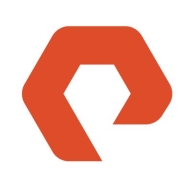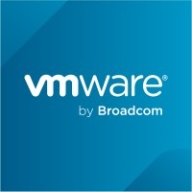


Find out what your peers are saying about Dell Technologies, NetApp, Hewlett Packard Enterprise and others in All-Flash Storage.
By opting for the gold subscription every three years, you get a free upgrade to the latest controller release.
If you wait more than seven years to buy another one, you get a return on your investment.
In the long term, spanning three to five years, the total cost of ownership becomes cheaper, considering power consumption, data center footprint, and NVMe technology usage.
We have seen a return on investment as the solution has reduced resource requirements, allowing less experienced personnel to manage the storage.
Starting with a smaller infrastructure and scaling as required allows us to save costs initially.
I have seen a return on investment; it's satisfactory in the long run.
We also had one outage where a controller of one of the products had failed and had to be replaced on-site.
Customers always have their issues resolved promptly.
Pure has good storage.
Pure's support organization is responsive with minimal bureaucracy, making support a key factor in customer retention.
The support from Pure Storage is excellent.
Opening a case with Pure is a smooth process, and they prove to be reliable, even in severe cases where infrastructure issues arise.
I would rate their support nine points.
I am not satisfied with VMware support, particularly with the reaction times, SLAs, and those kinds of issues.
Sometimes the issue is that you don't get the best experience, whether it's the response time or first-level support quality.
It is highly scalable.
It is suitable for both medium-sized and enterprise businesses.
It hasn't broken down anytime in the last six to seven years, despite hurricanes, earthquakes, and power outages.
A big banking client had around 300 petabytes of data on Pure Storage.
The solution is highly scalable, particularly when there is a need to expand capacity.
I rate FlashArray's scalability nine out of 10.
It supports up to 64 nodes in a cluster, allowing us to add nodes and expand the cluster as needed.
During the eight years, there have been no problems such as hardware failure or stopping.
I would rate the stability of the solution as a ten out of ten.
I would rate the stability of the product at seven out of ten.
For stability, I rate it a ten out of ten.
I have not encountered any significant issues, such as applying firmware that introduces bugs.
Stability has never been an issue except for minor controller glitches causing failover events, similar to brakes and tires on a car.
In terms of stability, I give VMware vSAN nine points.
We would appreciate a built-in transparent failover in the next release to eliminate the need for a separate metro cluster.
I'm eagerly anticipating the roadmap's promise of introducing multiple controllers, which could significantly boost scalability and resilience.
We mostly rely on long-term releases. We don't need the most up-to-date features, but we need a reliable environment.
Integrating object storage into the FlashArray would benefit entry-level and SMB customers by offering a more unified solution.
Storing cold data on expensive arrays doesn't make financial sense, and tiering to any of the big three cloud providers would be advantageous.
As a technical professional, I lack visibility into the system logs.
A proper monitoring tool that encompasses both applications and infrastructure would help in quickly resolving issues.
Maybe incorporation of automation to build clusters in a more automated way would be beneficial.
While the prices may be higher than those of other vendors, we see it as a market leader with benefits.
The support can be a bit pricey, but the solution is more cost-effective than anything else out there.
I would give it a nine out of ten in terms of costliness.
They're expensive.
While they say it's free, we actually pay for support upfront.
The cost of Pure FlashArray is a bit high compared to peers, but its sustainability and features justify the price.
This has resulted in a slight cost increase.
Pure Storage has signature security technology, which cannot be deleted, even if you are an administrator.
The platform's robust features include excellent sustainability tracking, and a comprehensive dashboard offering insights into IOPS, bandwidth, performance, and virtual activities.
Its data compression feature is the best that we have ever seen.
FlashArray's integration with the Pure One instrument provides a centralized platform for efficient management of all arrays.
Another noteworthy aspect is their platform, Pure One, a cloud-based analytics platform that automatically creates a case and sends out a part if a disk or controller fails.
It handles internal data migration seamlessly in the background without going offline, achieving a hundred percent uptime.
Hot add features are available by default in vSphere, allowing us to immediately increase memory, CPU, and hard drive without any downtime.
The VMware vSAN feature that has had the greatest impact on operational efficiency is the basic software-defined storage functionality.
A one-stack solution from one vendor is the main benefit here.
| Product | Market Share (%) |
|---|---|
| Pure Storage FlashArray | 6.4% |
| Dell PowerStore | 15.8% |
| HPE Alletra Storage | 10.0% |
| Other | 67.8% |
| Product | Market Share (%) |
|---|---|
| VMware vSAN | 13.9% |
| VxRail | 15.8% |
| Nutanix Cloud Infrastructure (NCI) | 9.6% |
| Other | 60.699999999999996% |



| Company Size | Count |
|---|---|
| Small Business | 15 |
| Midsize Enterprise | 11 |
| Large Enterprise | 12 |
| Company Size | Count |
|---|---|
| Small Business | 60 |
| Midsize Enterprise | 34 |
| Large Enterprise | 137 |
| Company Size | Count |
|---|---|
| Small Business | 98 |
| Midsize Enterprise | 58 |
| Large Enterprise | 128 |
Pure Storage FlashArray//X is the world’s first enterprise-class, all-NVMe flash storage array. It represents a new class of storage – shared accelerated storage, which is a term coined by Gartner – that delivers major breakthroughs in performance, simplicity, and consolidation.
Pure Storage FlashArray is the world’s first enterprise-class storage array that runs exclusively on the nonvolatile memory express (NVMe) protocol for memory access and storage. It represents a totally state-of-the-art type of storage technology. It offers users shared accelerated storage that delivers cutting-edge features in the realms of performance, simplicity, and consolidation. Pure Storage is fresh and modern today and will be for the next decade. Without forklift upgrades or planned downtime, Pure Storage takes the work out of storage ownership and delivers unprecedented customer satisfaction.
Pure Storage FlashArray is built with simplicity and reliability in mind. The solution can be implemented and optimized in hours, as opposed to other similar solutions that can take days. It has no moving parts, which removes areas where it could potentially be vulnerable to suffering errors. It is highly stable and gives users the ability to manage system shutdowns in a way that prevents data loss.
Benefits of Pure Storage FlashArray
Some of the benefits of using Pure Storage FlashArray include:
Reviews from Real Users
Pure Storage FlashArray is a highly effective piece of storage technology which stands out among its competitors for a number of reasons. Two major ones are its overall robustness and the value that it offers by way of its reliability and ease of use. It provides users with many valuable features that allow them to maximize what they can do with this solution. Pure Storage FlashArray’s reliability and ease of use make it a highly valuable solution.
PeerSpot user Prabakaran K., a technical consultant at Injazat Data Systems, notes the robustness of this solution when he writes, "FlashArray has many valuable features. It's very user-friendly and it has high availability, so there is comparatively less downtime. During maintenance, there is no shutdown procedure, so you can directly power off the Array and manage the shutdown process without any data loss, which is a unique feature. Managing replication and data migration is also very easy."
PeerSpot user Jason D., a cloud solutions architect at a tech services company, notes three features that make this solution valuable when he writes, "We've had different types of storage, and three things of this solution are valuable. The first one is its outstanding performance. The second one is its stability. In the about three years that we've had it, we've had component failures, but we never had a service interruption or any data loss. The third one, which is really critical, is that it is super easy to use in terms of provisioning, storage, and managing the arrays. I'm able to maintain a multi-site environment with a couple of dozen arrays with a single mid-level storage admin."
VMware vSAN is a software-defined storage product that is used in collaboration with VMware ESXi hypervisor and that provisions and manages storage based on policies, regardless of the underlying hardware. The solution enables you to prime your business for growth through its seamless evolution (it is integrated with vSphere and requires no new tools), its flexibility, and its multi-cloud capabilities. As an industry-leading software, VMware vSAN provides high levels of performance with minimal impact on CPU and memory.
VMware vSAN Features
VMware vSAN has many valuable key features. Some of the most useful ones include:
VMware vSAN Benefits
There are many benefits to implementing VMware vSAN. Some of the biggest advantages the solution offers include:
Reviews from Real Users
Below are some reviews and helpful feedback written by PeerSpot users currently using the VMware vSAN solution.
PeerSpot user Yves S., CEO, Cloud Evangelist at Comdivision Consulting GmbH, says, “vSAN gives us a lot of advantages when we need to expand resources. We have an overall larger host infrastructure, and we split that up for specific customer test and use cases. In that specific scenario, we can easily add more hosts or reduce the number of hosts in the environment.”
A reviewer who works in Infrastructure Security explains, “The ease of use is great. The initial setup and upgrade process was pretty straightforward. And, technical support is great.”
Laurent N., Director at Softlogic, comments, "The feature that I have found most valuable is that it is easy to deploy. It is easy to create and delete virtual servers. It is easy to create the load balancing and the clustering."
We monitor all All-Flash Storage reviews to prevent fraudulent reviews and keep review quality high. We do not post reviews by company employees or direct competitors. We validate each review for authenticity via cross-reference with LinkedIn, and personal follow-up with the reviewer when necessary.